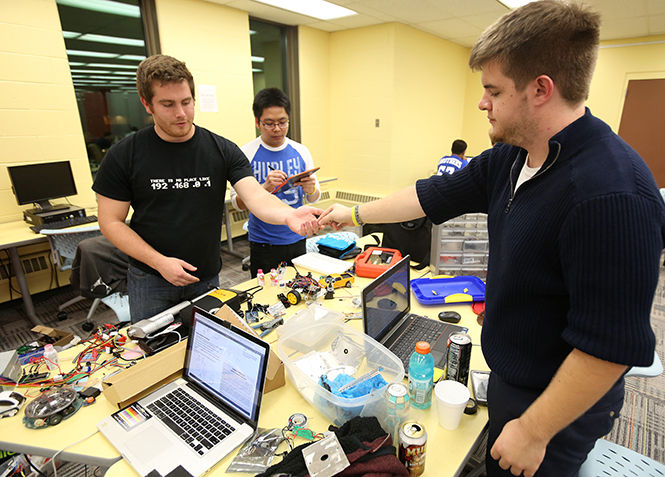Kent State Sudoku app takes first at hackathon
October 26, 2014
Kent State University’s student-organized group “HacKSU” hosted its annual “Hackathon” in the library this weekend for students to create new ideas with technology they use everyday.
The event, titled “Kent Hack Enough,” featured student programmers and computer designers not only from Kent State University but also from other universities across Ohio.
The hackathon is an event where students come together to create projects that advance technology and can help pave the way for new ideas. A team of judges decide the top three projects designed during the event. Prizes are awarded to each student who is a part of the top three designs.
The Hackathon activity began with an introduction in the KIVA Friday afternoon by HacKSU senior student leaders Robin Bonatesta and Paul Dilyard. Members of some of the 17 different sponsors on-hand during the three-day event also spoke to students about their companies.
Judges reward points to projects based off of three categories: technical difficulty, usability and polish.
Student judge Jack Kenyon expanded all three categories.
“Technical difficulty is one category, and it’s basically hurdles that people have to face, for instance, one group had to program their whole project in a language none of them have ever used before,” Kenyon said. “Usability is how easy a program is to use and polish is how well the overall project works and looks.”
The winner for best project was a computer program called “I-Sudo.” The program acts as an app that can take a video of a Sudoku puzzle and can read the puzzle and fill in any missing numbers. The app was designed by Kent State juniors Emil Shirima, Jiaming Xing, Chonghao Zhang and post-secondary student David Patuwo. The group won $2,000 in cash to split and each received a tablet.
The group said they were happy to win but were surprised at the final results.
“We were walking around and we saw people with robots and huge machines so we never expected to win,” Shirima said. “We were actually planning on sleeping much of the time.”
Finishing second and winning $1,000 was Case Western Reserve Uniersity senior Tom Emelko with his project, “Soundscape.” Soundscape takes the spectrum and frequency of music and makes a 3-D visualization using an oculus rift, which is a virtual reality helmet.
“When you put the headphones in, you are basically in your own little world,” Emelko said. “It is like watching music.”
In third place was the app called “Doodle Disorder.” The app was created by four Case Western students. Doodle Disorder is an app that allows you to draw different things on a boogie board and animate them, such as drawing a face and making the parts of it move.
Bonatesta was pleased about the event during the closing ceremony Sunday afternoon in the Kiva.
“This was one of the best Hackathons I can remember, mainly because there were so many good projects created,” Bonatesta said.
Contact Andrew Bugel at [email protected]
























